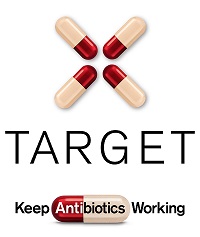Getting the most from the TARGET toolkit
 TARGET stands for: Treat Antibiotics Responsibly, Guidance, Education, Tools. The Toolkit includes a range of free resources that can each be used to support prescribers’ and patients’ responsible antibiotic use.
TARGET stands for: Treat Antibiotics Responsibly, Guidance, Education, Tools. The Toolkit includes a range of free resources that can each be used to support prescribers’ and patients’ responsible antibiotic use.
Version 1.0, November 2021.
Theoretical background
The TARGET resources are based on several behavioural theories, the Theory of Planned Behaviour, the Behaviour Change Wheel and the Theoretical Domains Framework.
The model proposes that human behaviour is driven by three considerations and these considerations are able to predict whether a person intends to do something. These are:
- Personal Attitude and outcome beliefs: Whether the person is in favour of doing something
- Subjective Norm and normative values: How much the person feels social pressure to do it
- Perceived Behavioural Control and control beliefs: Whether the person feels in control of the action in question
Thus, in order for prescribers (individual and teams), and patients to change their antibiotic use they need to:
- be convinced of the importance of antibiotic resistance and how their responsible antibiotic use can contribute to controlling resistance.
- have the confidence, motivation and tools to use antibiotics responsibly.
The Theory of Planned Behaviour Applied to the TARGET Toolkit
Abbreviations: CCG = Clinical Commissioning Group

In this context, the TARGET Antibiotics Toolkit attempts to:
- influence personal attitudes to antibiotic resistance by emphasising the patient and population benefits of reducing antibiotic use and by showing that appropriate prescribing can make a difference to resistance;
- influence the subjective norms by raising awareness in the practice and nationally of the importance of antibiotic resistance and responsible prescribing, by feeding back practice prescribing rates compared to other practices locally and nationally and by describing the strategies used by peers to reduce antibiotic prescribing;
- influence perceived behavioural controls by increasing confidence of prescribers and patients to use antibiotics responsibly using guidance and leaflets and explaining how barriers to reducing antibiotic prescribing can be overcome.
Using a combination of the different TARGET resources can increase an individual’s intention to “use antibiotics responsibly”. However, other external barriers and patient characteristics may still influence or prevent responsible prescribing.
- Action planning within a practice or out of hours team is essential to move the intentions into actual actions.
- Audits are important to monitor changes in prescribing and highlight the need to discuss other external barriers.
- Incentives or indicators will influence behaviour through changing personal attitudes and subjective norms.
The Behaviour Change Wheel
The Behaviour Change Wheel (BCW) was developed to inform interventions to change behaviour. In the centre of the BCW is a ‘behaviour system,’ which describes essential conditions for a behaviour to occur; capability, opportunity, and motivation (COM) must interact to generate a behaviour.
- Capability - the individual’s psychological (self efficacy) and physical capacity (control, skills) to engage in the activity concerned.
- Motivation - brain processes that energize and direct behaviour, it includes habitual processes, emotional responding (fear, attitudes), as well as analytical decision-making (health motivation).
- Opportunity - factors that lie outside the individual that make the behaviour possible or prompt it. (barriers, cues to action, social norms)
While this is a model of behaviour, it also provides a basis for designing interventions aimed at behaviour change. Interventions and policy changes can be designed to target aspects of the behaviour identified in the COM behaviour system; some interventions may target multiple areas of behaviour.
The Behaviour Change Wheel (adapted from Michie, 2011)
The Theoretical Domains Framework
The Theoretical Domains Framework (TDF) was developed by a collaboration of behavioural scientists and researchers in order to develop a ‘one-size-fits-all’ evidence based, theory-informed framework to identify determinants of behaviour. The TDF includes 14 domains to describe behaviour (see table below), for example, knowledge, skills, beliefs about capabilities.
The TDF can be a theoretical basis for research to identify behaviours which can be targeted with interventions. The TDF can be used hand-in hand with the Behaviour Change Wheel, as the domains of the TDF can fit into the COM Behaviour system.
The TARGET team often use the TDF and BCW in research studies to inform the development of interventions, to evaluate the implementation of interventions.
The Theoretical Domains Framework and COM-B Behaviour system. Adapted from (Atkins, 2017)
References:
- Michie S, van Stralen MM, West R. The behaviour change wheel: a new method for characterising and designing behaviour change interventions. Implement Sci. 2011 Apr 23;6:42. doi: 10.1186/1748-5908-6-42. PMID: 21513547; PMCID: PMC3096582.
- Atkins, L., Francis, J., Islam, R. et al. A guide to using the Theoretical Domains Framework of behaviour change to investigate implementation problems. Implementation Sci 12, 77 (2017). https://doi.org/10.1186/s13012-017-0605-9
- Ajzen I. (1985) From Intentions to Actions: A Theory of Planned Behavior. In: Kuhl J., Beckmann J. (eds) Action Control. SSSP Springer Series in Social Psychology. Springer, Berlin, Heidelberg. https://doi.org/10.1007/978-3-642-69746-3_2